









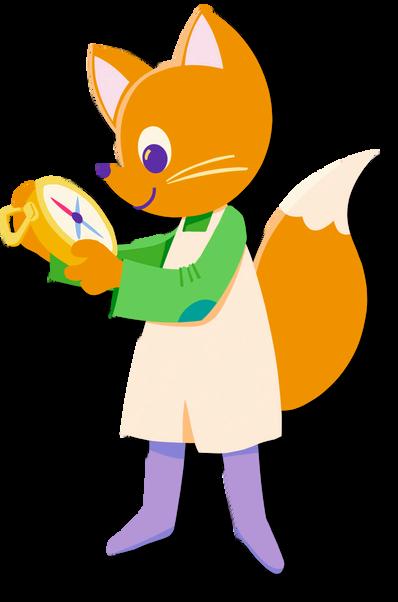
Seesaw's Early Literacy program focuses on developing essential literacy skills in young learners. The curriculum emphasizes critical areas such as phonemic awareness, letter recognition, phonics, decoding, and text comprehension.






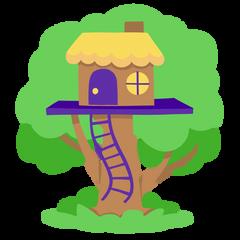
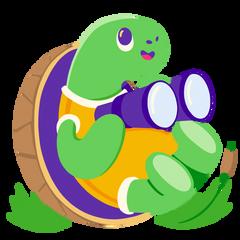


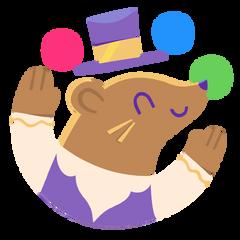
Phonological Awareness
Phonics & Decoding
Word Recognition & Fluency
Vocabulary & Oral
Language
Comprehension
Text Comprehension

These lessons systematically target various aspects of phonemic awareness. Students develop phonemic awareness by listening to, identifying, matching, adding, and substituting sounds to build awareness of each phoneme. These lessons provide a structured approach to developing phonemic awareness, supporting students' progression from basic sound recognition to more complex phoneme manipulation tasks.

These lessons allow students to practice the alphabetic principle through a series of hands-on and multi-sensory lessons that invite them to practice letter identification, letter formation, phonemic awareness, and make connections to each letter in the real world These lessons systematically build students' grapheme-phoneme correspondence skills, supporting their progression from letter recognition to early reading and writing proficiency.

These lessons support emergent readers with developing comprehensive letter knowledge and phonological awareness for each letter of the alphabet. Through multisensory activities, students strengthen their visual discrimination, auditory processing, and fine motor skills essential for early reading success. The lessons incorporate explicit instruction in both uppercase and lowercase letter forms, supporting the development of print concepts and fostering a strong understanding of the alphabetic principle.

These lessons feature two types of books designed to support oral language and early literacy development: Letter Books and Sound & Word Books. The Letter Books focus on individual letters/digraphs and their corresponding sounds, helping students identify letters/digraphs in context and recognize words beginning with specific phonemes. The Sound & Word Books build on this foundation, guiding students through decoding practice with short vowels, long vowels, blends, digraphs, double final consonants, and inflectional endings.

This collection of over 100 lessons focuses on high-frequency word recognition through a multi-faceted approach, incorporating explicit instruction, guided practice, and a variety of activities designed to enhance word recognition, spelling proficiency, and contextual understanding. By integrating reading, writing, speaking, and listening skills, these lessons lay a strong foundation for reading fluency and comprehension.

This comprehensive collection features a series of phonics lessons focusing on specific sound-spelling patterns. Each lesson guides students through activities that include sorting, blending, segmenting, and changing words, as well as dictation exercises. Through these structured yet flexible activities, students develop phonological awareness and phonics skills, laying the groundwork for their success in reading and writing.

These lessons serve as an instructional starting point for teachers to develop students' phonics skills and word analysis strategies through the exploration of various sound-spelling and syllable patterns. Through engaging activities and discussions facilitated by the teacher, students deepen their understanding of these patterns, enhancing their ability to decode unfamiliar words and apply their knowledge. This collection aims to build students' confidence and proficiency in recognizing and using a wide range of sound-spelling patterns.


Theselessonsfeaturecarefullycraftedtextsthat systematicallyintroduceandreinforcespecificsoundspellingandsyllablepatterns,supportingstudents'phonics developmentandreadingfluency.Eachlessonincorporates targetedwordwork,fluencypractice,andcomprehension activities,providingstudentswithmultipleopportunitiesto applytheirphonicsskillsinmeaningfulcontexts.


This collection of PK-2 phonics games offers versatile, customizable activities designed to reinforce phonemic awareness, letter recognition, decoding, and spelling through engaging offline interactions. These independent and partner-based games provide students with opportunities to apply and consolidate their phonics skills in a playful, hands-on environment, complementing digital learning experiences. By incorporating these games into instruction, educators can ensure a balanced approach to phonics practice, promoting active learning and social interaction while reinforcing essential literacy skills.


These lessons are designed to provide students with independent practice opportunities, reinforcing the phonics skills introduced in the teacher-facilitated Word Analysis Station lessons. Students engage with various sound-spelling patterns through a series of interactive exercises, including open and closed sorts, timed sorts, and word ladder activities. The collection also incorporates dictation exercises and open writing activities, bridging the gap between phonics instruction and practical application in writing.



With Seesaw Early Literacy, our mission is to foster joyful learning opportunities for both educators and students alike. We hope that these lessons not only supplement your teaching but also inspire a love for early literacy in your students. Together, let’s embark on a journey of exploration, discovery, and meaningful engagement in the world of literacy.
Seesaw Early Literacy’s Prek-TK 30-week scope and sequence is organized from high-utility to low-utility letters and sound-spelling patterns. It builds upon the simplest to most complex skills, ensuring a strategic progression in literacy development that is guided by the principle that many words can be formed as early as possible (Blevins, 2017).
This scope and sequence of lessons is thoughtfully crafted to align with the dynamic needs of teachers’ classrooms.
Within this framework, teachers are encouraged to explore and select any of the lessons listed for a particular week, allowing the freedom to tailor their instruction to best meet instructional objectives and students’ needs. Whether teachers prefer whole-class engagement, collaborative partner activities, interactive small group centers, individualized review work, or any other pedagogical approach, these lessons can be seamlessly integrated into a teacher’s existing curriculum.


• Capital Letter “M”
• Sing & Play With Letters: “M”
• What Else Begins With “M?”
• Lowercase Letter “m”
• Capital Letter “A”
• Sing & Play With Letters: “A”
• What Else Begins With “A?”
• Lowercase Letter “a”
• Capital Letter “S”
• Sing & Play With Letters: “S”
• What Else Begins With “S?”
• Lowercase Letter “s”
• Capital Letter “P”
• Sing & Play With Letters: “P”
• What Else Begins With “P?”
• Lowercase Letter “p”


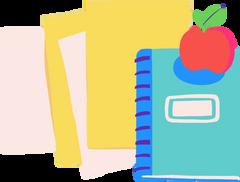
• Capital Letter “T”
• Sing & Play With Letters: “T”
• What Else Begins With “T?”
• Lowercase Letter “t”
• Capital Letter “I”
• Sing & Play With Letters: “I”
• What Else Begins With “I?”
• Lowercase Letter “i”
•CapitalLetter“N”
•Sing&PlayWithLetters:“N”
•WhatElseBeginsWith“N?”
•LowercaseLetter“n”
•CapitalLetter“B”
•Sing&PlayWithLetters:“B”
•WhatElseBeginsWith“B?”
•LowercaseLetter“b”


• Capital Letter “C”
• Sing & Play With Letters: “C”
• What Else Begins With “C?”
• Lowercase Letter “c”
• Capital Letter “O”
• Sing & Play With Letters: “O”
• What Else Begins With “O?”
• Lowercase Letter “o”
• Capital Letter “F”
• Sing & Play With Letters: “F”
• What Else Begins With “F?”
• Lowercase Letter “f”
• Capital Letter “H”
• Sing & Play With Letters: “H”
• What Else Begins With “H?”
• Lowercase Letter “h”



• Capital Letter “D”
• Sing & Play With Letters: “D”
• What Else Begins With “D?”
• Lowercase Letter “d”
• Capital Letter “R”
• Sing & Play With Letters: “R”
• What Else Begins With “R?”
• Lowercase Letter “r”
• Capital Letter “G”
• Sing & Play With Letters: “G”
• What Else Begins With “G?”
• Lowercase Letter “g”
• Capital Letter “E”
• Sing & Play With Letters: “E”
• What Else Begins With “E?”
• Lowercase Letter “e”



• Capital Letter “L”
• Sing & Play With Letters: “L”
• What Else Begins With “L?”
• Lowercase Letter “l”
• Capital Letter “K”
• Sing & Play With Letters: “K”
• What Else Begins With “K?”
• Lowercase Letter “k”
• Capital Letter “U”
• Sing & Play With Letters: “U”
• What Else Begins With “U?”
• Lowercase Letter “u”
• Capital Letter “W”
• Sing & Play With Letters: “W”
• What Else Begins With “W?”
• Lowercase Letter “w”



• Capital Letter “J”
• Sing & Play With Letters: “J”
• What Else Begins With “J?”
• Lowercase Letter “j”
• Capital Letter “X”
• Sing & Play With Letters: “X”
• What Else Has an “X?”
• Lowercase Letter “x”
• Capital Letter “V”
• Capital Letter “Q”
• Sing & Play With Letters: “Q”
• Sing & Play With Letters: “V”
• What Else Begins With “Q?”
• What Else Begins With “V?”
• Lowercase Letter “q”
• Lowercase Letter “v”
• Capital Letter “Y”
• Capital Letter “Z”
• Sing & Play With Letters: “Y”
• Sing & Play With Letters: “Z”
• What Else Begins With “Y?”
• What Else Begins With “Z?”
• Lowercase Letter “y”
• Lowercase Letter “z”


This resource is designed to provide educators with an example weekly framework using Seesaw Early Literacy lessons. This example shows how lessons can be strategically implemented throughout a typical week to supplement or enhance any existing literacy curriculum.
Note: Each week focuses on key aspects of early literacy, such as phonemic awareness and letter identification, incorporating hands-on activities and interactive experiences to engage learners and promote meaningful learning.
FunPhonemes
Lessons: The/m/Sound
Module(s): Introduction,Practice Collection: AlphabetGarden
Lesson: WhatElseBeginsWith“M?”
Module(s): Introduction
Collection: FunPhonemes
Lessons: The/m/Sound
Module(s): Apply:IsolatetheSound, Apply:AddtheSounds
Collection: FunPhonemes
Lessons: The/m/Sound
Module(s): Connect
Collection: FunPhonemes
Lessons: The/m/Sound
Module(s): ShowWhatYouKnow
Collection: AlphabetGarden
Lesson: WhatElseBeginsWith“M?”
Module(s): Practice
Collection: AlphabetGarden
Lesson: WhatElseBeginsWith“M?”
Module(s): Apply
Collection: AlphabetGarden
Lesson: WhatElseBeginsWith“M?”
Module(s): ShowWhatYouKnow
Collection: Letter&WordBook Treehouse
Lesson: TheMmBook(LetterBook)
Module(s): Listen
Collection: Letter&WordBook Treehouse
Lesson: TheMmBook(LetterBook)
Module(s): Read
Collection: Letter&WordBook Treehouse
Lesson: TheMmBook(LetterBook)
Module(s): Read
Collection: Letter&WordBook Treehouse
Lesson: TheMmBook(LetterBook)
Module(s): Read
Collection: AlphabetGarden
Lesson: CapitalLetter“M”
Module(s): Introduction
Collection: AlphabetGarden
Lesson: CapitalLetter“M”
Module(s): Practice
Collection: AlphabetGarden
Lesson: CapitalLetter“M”
Module(s): Apply
Collection: AlphabetGarden
Lesson: CapitalLetter“M”
Module(s): ShowWhatYouKnow

Collection: AlphabetGarden
Lesson: LowercaseLetter“m”
Module(s): Introduction
Collection: AlphabetGarden
Lesson: LowercaseLetter“m”
Module(s): Practice
Collection: AlphabetGarden
Lesson: LowercaseLetter“m”
Module(s): Apply
Collection: AlphabetGarden
Lesson: LowercaseLetter“m”
Module(s): ShowWhatYouKnow


With Seesaw Early Literacy, our mission is to foster joyful learning opportunities for both educators and students alike. We hope that these lessons not only supplement your teaching but also inspire a love for early literacy in your students. Together, let’s embark on a journey of exploration, discovery, and meaningful engagement in the world of literacy.
Seesaw Early Literacy’s Kindergarten 30-week scope and sequence is organized from high-utility to low-utility letters and sound-spelling patterns. It builds upon the simplest to most complex skills, ensuring a strategic progression in literacy development that is guided by the principle that many words can be formed as early as possible (Blevins, 2017).
This scope and sequence of lessons is thoughtfully crafted to align with the dynamic needs of teachers’ classrooms. Within this framework, teachers are encouraged to explore and select any of the lessons listed for a particular week, allowing the freedom to tailor their instruction to best meet instructional objectives and students’ needs. Whether teachers prefer whole-class engagement, collaborative partner activities, interactive small group centers, individualized review work, or any other pedagogical approach, these lessons can be seamlessly integrated into a teacher’s existing curriculum.

• The /m/ Sound
• The /æ/ (cat) Sound
• The /s/ Sound

• The /p/ Sound
• The /t/ Sound
• The /ɪ/ (fish) Sound
• The Letter Mm
• The Letter Aa
• The Letter Ss
• The Mm Book
• The Aa Book
• The Ss Book
• The Letter Pp
• The Letter Tt
• The Letter Ii
• The Pp Book
• The Tt Book
• The Ii Book
• The /n/ Sound
• The /b/ Sound
• The /k/ Sound
• The Letter Nn
• The Letter Bb
• The Letter Cc
• The Nn Book
• The Bb Book
• The Cc Book
• The /ŏ/ (lock) Sound
• The /f/ Sound
• The /h/ Sound
• The Letter Oo
• The Letter Ff
• The Letter Hh
• The Oo Book
• The Ff Book
• The Hh Book


• The /d/ Sound
• The /r/ Sound
• The /g/ Sound
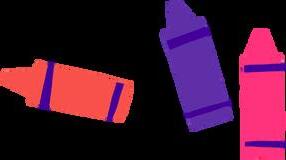
• The Letter Dd
• The Letter Rr
• The Letter Gg
• The Dd Book
• The Rr Book
• The Gg Book
• The /ɛ/ (bed) Sound
• The /l/ Sound
• The /k/ Sound ** (2nd time)
• The Letter Ee
• The Letter Ll
• The Letter Kk
• The Ee Book
• The Ll Book
• The Kk Book
• The /ə/ (duck) Sound
• The /w/ Sound
• The /dʒ/ (jump) Sound
• The /v/ Sound
• The /y/ Sound
• The /z/ Sound
• The Letter Uu
• The Letter Ww
• The Letter Jj
• The Letter Xx
• The Letter Vv
• The Letter Qq
• The Letter Yy
• The Letter Zz
• The Uu Book
• The Ww Book
• The Jj Book
• The Xx Book
• The Vv Book
• The Qq Book
• The Yy Book
• The Zz Book


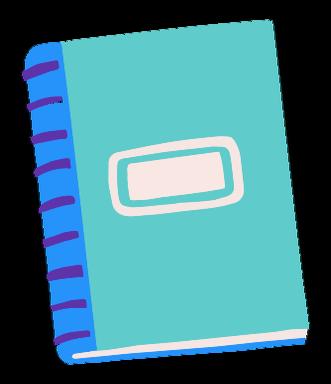
• “m” Sound-Spelling Board
• “a” Sound-Spelling Board
• “s” Sound-Spelling Board
the
of
and
• Short “a” Sound & Word Book #1
• Short “e” Sound & Word Book #1
• “p” Sound-Spelling Board
• “t” Sound-Spelling Board
• “i” Sound-Spelling Board
you
a
to
• Short “i” Sound & Word Book #1
• Short “u” Sound & Word Book #1
• “n” Sound-Spelling Board
• “b” Sound-Spelling Board
• “c” Sound-Spelling Board
• “o” Sound-Spelling Board
• “f” Sound-Spelling Board
• “h” Sound-Spelling Board
in is it
that
he
was
• Short “i” Sound & Word Book #2
• Short “u” Sound & Word Book #2
• Short “o” Sound & Word Book #1
• Short “a” Sound & Word Book #2



• “d” Sound-Spelling Board
• “r” Sound-Spelling Board
• “g” Sound-Spelling Board
• “e” Sound-Spelling Board
• “l” Sound-Spelling Board
• “k” Sound-Spelling Board
• “u” Sound-Spelling Board
• “w” Sound-Spelling Board
• “j” Sound-Spelling Board
• “x” Sound-Spelling Board
• “v” Sound-Spelling Board
• “qu” Sound-Spelling Board
• “y” Sound-Spelling Board
• “z” Sound-Spelling Board



Vowels
• “sh” Sound-Spelling Board
• “ch” Sound-Spelling Board
• “th” Sound-Spelling Board
• “tch” and “wh” Sound-Spelling Board
• “-s” at the end Sound-Spelling Board
• Inflectional Ending “ing” Board
• Inflectional Ending “ed” Board
• Long “a” Sound-Spelling Board
• Long “i” Sound-Spelling Board
• Long “o” Sound-Spelling Board
• Long “u” Sound-Spelling Board
• “ss” Sound-Spelling Board
• “ll” Sound-Spelling Board
• “ff” and “zz” Sound-Spelling Board
or
one
had
• The “sh-” Book
• The “ch-” Book
• The “th-” Book
• The “wh-” Book
• The “-sh” Book
• The “-ch” Book
by
words
but
•
•
•
Inflectional Ending “-s” Sound & Word Book Inflectional Ending “-ing” Sound & Word Book Inflectional Ending “-ed” Sound & Word Book
• Long “a” Sound & Word Book #1
not
what
all
• Long “a” Sound & Word Book #2
• Long “i” Sound & Word Book #1
• Long “i” Sound & Word Book #2
• Long “o” Sound & Word Book
• Flip It! Read It! Swat It!
• Fix the Word
• • Shout It, Sound It! Shout It, Spell It!
• Move and Groove
• Hopscotch
• Connect Four
• Minute to Write It
• Hot or Cold Tic-Tac-Toe
were
we
when
•
•
•
• Long “u” Sound & Word Book “ss” Sound & Word Book
“ll” Sound & Word Book “ff” and “zz” Sound & Word Book
• Build and Create Letters
• Build and Create New Words
• Telephone
• Go Fish!



Dan the Rat (Short “a”)
• Paparazzi
• Environmental Road Trip
• Life-Size Game Board
The Big Rip (Short “i”)
• Make a Song
• Store Eye Spy
• Pictionary
Tom and the Dog (Short “o”)
In the Mud (Short “u”)
• Stack and Say
• Stack and Read
• Throw and Catch
• Eye Spy
• Roll, Write, and Say!
• Roll, Write, and Read!
• Memory
• Run With It
Meg Needs a Pen (Short “e”)
• Write the Room
• Writing in the Air
• Setting the Table
Week-At-A-Glance
Example

This resource is designed to provide educators with an example weekly framework using Seesaw Early Literacy lessons. This example shows how lessons can be strategically implemented throughout a typical week to supplement or enhance any existing literacy curriculum.
Note: These weeks offer opportunities to introduce or reinforce students’ knowledge of foundational phonemes and letters. Each day focuses on key aspects of early literacy, such as phonemic awareness, phonics, and letter formation.
Collection: FunPhonemes
Whole Group Instruction
Small Group Or Independent Practice
Lessons: The/m/Sound The/æ/(cat)Sound The/s/Sound
Module(s): Introduction
Collection: AlphabetTreasures
Lesson: TheLetterMm TheLetterAa TheLetterSs
Module(s): Listen
Collection: AlphabetTreasures
Partner or Center Activity
Lesson: TheLetterMm TheLetterAa TheLetterSs
Module(s): Connect

Collection: Letter&WordBook Treehouse
Lesson: TheMmBook
Module(s): ListenorRead
Collection: AlphabetTreasures
Lesson: TheLetterMm
Module(s): Identify,Write
Collection: FunPhonemes
Lesson: The/m/Sound
Module(s): Apply:Isolate,Apply:Add, Connect
Collection: AlphabetTreasures
Formative Assessment
Lesson: TheLetterMm
Module(s): ShowWhatYouKnow
Collection: Letter&WordBook Treehouse
Lesson: TheAaBook
Module(s): ListenorRead
Collection: AlphabetTreasures
Lesson: TheLetterAa
Module(s): Identify,Write
Collection: FunPhonemes
Lesson: The/æ/(cat)Sound
Module(s): Apply:Isolate,Apply:Add, Connect
Collection: AlphabetTreasures
Lesson: TheLetterAa
Module(s): ShowWhatYouKnow
Collection: Letter&WordBook Treehouse
Lesson: TheSsBook
Module(s): ListenorRead
Collection: AlphabetTreasures
Lesson: TheLetterSs
Module(s): Identify,Write
Collection: FunPhonemes
Lesson: The/s/Sound
Module(s): Apply:Isolate,Apply:Add, Connect
Collection: AlphabetTreasures
Lesson: TheLetterSs
Module(s): ShowWhatYouKnow
Collection: AlphabetTreasures
Lessons: TheLetterMm TheLetterAa TheLetterSs
Module(s): Introduction
Collection: Letter&WordBook Treehouse
Lesson: TheMmBook TheAaBook TheSsBook
Module(s): Read
Collection: FunPhonemes
Lesson: EachFocusSound
Module(s): Practice
Week-At-A-Glance
Example

Collection: PhenomenalPhonics
This resource is designed to provide educators with an example weekly framework using Seesaw Early Literacy lessons. This example shows how lessons can be strategically implemented throughout a typical week to supplement or enhance any existing literacy curriculum.
Note: These weeks offer opportunities to deepen students’ letter-sound knowledge and introduce students to high-frequency words. Each day focuses on key aspects of early literacy, such as phonics, word recognition, and decoding. Formative Assessment Whole Group Instruction
Lessons: “o”Sound-SpellingBoard Module(s): Introduction,Sort Collection:
High-FrequencyWordsWithTurtle Lessons: that Module(s): Introduction,Find
Collection: PhenomenalPhonics
Lessons: “o”Sound-SpellingBoard Module(s): Blend,Segment,Change
Collection: High-FrequencyWordsWithTurtle Lessons: that
Module(s): Analyze,Spell,SentencePractice
Collection: PhenomenalPhonics
Lessons: “o”Sound-SpellingBoard
Module(s): Write,Play,Connect
Collection: High-FrequencyWordsWithTurtle Lessons: that
Module(s): Write,Create,Connect
Collection: PhenomenalPhonics
Lessons: “o”Sound-SpellingBoard Module(s): QuickCheck
Collection: High-FrequencyWordsWithTurtle Lessons: that
Module(s): ShowWhatYouKnow
Collection PhenomenalPhonics
Lessons: “f”Sound-SpellingBoard Module(s): Introduction,Sort Collection High-FrequencyWordsWithTurtle Lessons: he Module(s): Introduction,Find
Collection PhenomenalPhonics
Lessons: “f”Sound-SpellingBoard Module(s): Blend,Segment,Change
Collection
High-FrequencyWordsWithTurtle Lessons: he
Module(s): Analyze,Spell,SentencePractice
Collection
PhenomenalPhonics
Lessons: “f”Sound-SpellingBoard Module(s): Write,Play,Connect
Collection High-FrequencyWordsWithTurtle Lessons: he
Module(s): Write,Create,Connect
Collection PhenomenalPhonics
Lessons: “f”Sound-SpellingBoard Module(s): QuickCheck
Collection High-FrequencyWordsWithTurtle Lessons: he
Module(s): ShowWhatYouKnow
Collection: PhenomenalPhonics
Lessons: “h”Sound-SpellingBoard Module(s): Introduction,Sort Collection: High-FrequencyWordsWithTurtle Lessons: was Module(s): Introduction,Find
Collection: PhenomenalPhonics
Lessons: “h”Sound-SpellingBoard Module(s): Blend,Segment,Change
Collection:
High-FrequencyWordsWithTurtle Lessons: was
Module(s): Analyze,Spell,SentencePractice
Collection: PhenomenalPhonics
Lessons: “h”Sound-SpellingBoard Module(s): Write,Pay,Connect
Collection: High-FrequencyWordsWithTurtle Lessons: was
Module(s): Write,Create,Connect
Collection: PhenomenalPhonics
Lessons: “h”Sound-SpellingBoard Module(s): QuickCheck
Collection: High-FrequencyWordsWithTurtle Lessons: was
Module(s): ShowWhatYouKnow
Collection: Letter&WordBookTreehouse
Lessons: Short“o”Sound&WordBook#1 Module(s): Listen,Read
Collection: High-FrequencyWordsWithTurtle Lessons: HFWReviewGamesWeek14 Module(s): HFWGame1,HFWGame2
Collection: Letter&WordBookTreehouse
Lessons: Short“o”Sound&WordBook#1
Module(s): Listen,Read
Collection: High-FrequencyWordsWithTurtle Lessons: that
Module(s): HFWGame1,HFWGame2
Collection: Letter&WordBookTreehouse
Lessons: Short“o”Sound&WordBook#1 Module(s): Read
Collection: High-FrequencyWordsWithTurtle Lessons: that
Module(s): HFWGame1,HFWGame2
Collection: Letter&WordBookTreehouse
Lessons: Short“o”Sound&WordBook#1 Module(s): Read
Collection: High-FrequencyWordsWithTurtle Lessons: that
Module(s): HFWGame2
Collection: Letter&WordBookTreehouse
Lessons: Short“a”Sound&WordBook#1
Module(s): Listen,Read
Collection: High-FrequencyWordsWithTurtle Lessons: HFWReviewGamesWeek14 Module(s): HFWGame3,HFWGame4
Collection: Letter&WordBookTreehouse
Lessons: Short“a”Sound&WordBook#1
Module(s): Listen,Read
Collection: High-FrequencyWordsWithTurtle Lessons: that
Module(s): HFWGame3,HFWGame4
Collection: Letter&WordBookTreehouse
Lessons: Short“a”Sound&WordBook#1 Module(s): Read
Collection: High-FrequencyWordsWithTurtle Lessons: that
Module(s): HFWGame3,HFWGame4
Collection: Letter&WordBookTreehouse
Lessons: Short“a”Sound&WordBook#1 Module(s): Read
Collection: High-FrequencyWordsWithTurtle Lessons: that
Module(s): HFWGame4
Week-At-A-Glance
Example

This resource is designed to provide educators with an example weekly framework using Seesaw Early Literacy lessons. This example shows how lessons can be strategically implemented throughout a typical week to supplement or enhance any existing literacy curriculum.
Note: These weeks offer mini units that focus on digraphs, inflectional endings, long vowels, and double consonants. Each day in the week provides opportunities to practice blending, segmenting, and word recognition.
had
Whole Group Instruction
Small Group Or Independent Practice
Collection: PhenomenalPhonics
Lesson: “sh”Sound-SpellingBoard
Module(s): Intro,Sort,Blend, Segment
Collection: LetterandWordBook Treehouse
Lesson: “sh”Sound&WordBook
Module(s): Read
Collection: PhenomenalPhonics
Lesson: “ch”Sound-SpellingBoard
Module(s): Intro,Sort,Blend, Segment
Collection: LetterandWordBook Treehouse
Lesson: “ch/wh”Sound&WordBook
Module(s): Read
Collection: PhenomenalPhonics
Lesson: “th”Sound-SpellingBoard
Module(s): Intro,Sort,Blend, Segment
Collection: LetterandWordBook Treehouse
Lesson: “th”Sound&WordBook
Module(s): Read
Collection: High-FrequencyWords WithTurtle
Collection: High-FrequencyWords WithTurtle
Collection: High-FrequencyWords WithTurtle
Collection: PhenomenalPhonics
Lesson: “tch”&“wh”SoundSpellingBoard
Module(s): Intro,Sort,Blend, Segment
Collection: LetterandWordBook Treehouse
Lesson: “tch”Sound&WordBook
Module(s): Read
Collection: PhenomenalPhonics
Lessons: Chooseanyofthisweek’s boardsforcontinuedpractice
Module(s): Change,Write
Collection: PhenomenalPhonics
Lessons: Chooseanyofthisweek’s boardsforcontinuedpractice
Module(s): Change,Write
Collection: PhonicsGames
Collection: PhonicsGames
Partner or Center Activity
Lesson: or
Module(s): Any
Collection: High-FrequencyWords WithTurtle
Formative Assessment
Lesson: or
Module(s): ShowWhatYouKnow
Lesson: one
Module(s): Any
Collection: High-FrequencyWords WithTurtle
Lesson: one
Module(s): ShowWhatYouKnow
Lesson: had
Module(s): Any
Collection: High-FrequencyWords WithTurtle
Lesson: had
Module(s): ShowWhatYouKnow
Lesson: ShoutIt,SoundIt! ShoutIt,SpellIt!
Module(s): Watch&Play:Letters,Watch &Play:Words
Collection: PhenomenalPhonics
Lesson: “sh”Sound-SpellingBoard “ch”Sound-SpellingBoard
Module(s): QuickCheck
Lesson: FixtheWord
Module(s): Watch&Play:Letters,Watch &Play:Words
Collection: PhenomenalPhonics
Lesson: “th”Sound-SpellingBoard “tch&wh”Sound-Spelling Board
Module(s): QuickCheck
Week-At-A-Glance
Example

This resource is designed to provide educators with an example weekly framework using Seesaw Early Literacy lessons. This example shows how lessons can be strategically implemented throughout a typical week to supplement or enhance any existing literacy curriculum.
Note: These final weeks deepen students’ understanding and application of short vowels with short reading passages. Each day in the week provides opportunities to practice decoding, word recognition, reading comprehension, and fluency.
Whole Group Instruction
Small Group Or Independent Practice
Collection: PhenomenalPhonics
Lesson: "a"(-ag,-ad)SoundSpellingBoard
Module(s): Introduction
Collection: PassagesPlayhouse
Lesson: “DantheRat(Short“a”)
Module(s): Preview,Act1:EchoRead andMore
Collection: PhenomenalPhonics
Lesson: "a"(-ag,-ad)SoundSpellingBoard
Module(s): Sort
Collection: PassagesPlayhouse
Lesson: “DantheRat(Short“a”)
Module(s): Act2:PracticeReadand More!
Collection: PhenomenalPhonics
Lesson: "a"(-ag,-ad)SoundSpellingBoard
Module(s): Blend
Collection: PassagesPlayhouse
Lesson: “DantheRat(Short“a”)
Module(s): Act3:ChoralReadand More!
Collection: PhenomenalPhonics
Lesson: "a"(-ag,-ad)SoundSpellingBoard
Module(s): Segment
Collection: PassagesPlayhouse
Lesson: “DantheRat(Short“a”)
Module(s): Act4:Reader’sTheaterand More!
Collection: PhenomenalPhonics
Lesson: "a"(-ag,-ad)SoundSpellingBoard
Module(s): Change
Collection: PassagesPlayhouse
Lesson: “DantheRat(Short“a”)
Module(s): Act5:ReadonYourOwn andMore!
Partner or Center Activity
Collection: High-FrequencyWords WithTurtle
Lesson: your
Module(s): Any
Collection: High-FrequencyWords WithTurtle
Collection: High-FrequencyWords WithTurtle
Lesson: can
Module(s): Any
Collection: High-FrequencyWords WithTurtle
Collection: High-FrequencyWords WithTurtle
Lesson: said
Module(s): Any
Collection: High-FrequencyWords WithTurtle
Collection: PhonicsGames
Lesson: Paparazzi
Module(s): Watch&Play:Letters,Watch &Play:Words
Collection: PhenomenalPhonics
Collection: PhonicsGames
Lesson: Life-SizeGameBoard
Module(s): Watch&Play:Letters,Watch &Play:Words
Optional:
Formative Assessment
Lesson: your
Module(s): ShowWhatYouKnow
Lesson: can
Module(s): ShowWhatYouKnow
Lesson: said
Module(s): ShowWhatYouKnow
Lesson: "a"(-ag,-ad)SoundSpellingBoard
Module(s): QuickCheck
Listen to students reading or check responses from centers.


With Seesaw Early Literacy, our mission is to foster joyful learning opportunities for both educators and students alike. We hope that these lessons not only supplement your teaching but also inspire a love for early literacy in your students. Together, let’s embark on a journey of exploration, discovery, and meaningful engagement in the world of literacy.
Seesaw Early Literacy’s 1st Grade 30-week scope and sequence is organized from high-utility to low-utility skills. It builds upon the simplest to the most complex understanding of words, ensuring a strategic progression in literacy development guided by the principle that continuous application of previous learning is important (Blevins, 2017).
This scope and sequence of lessons is thoughtfully crafted to align with the dynamic needs of teachers’ classrooms. Within this framework, teachers are encouraged to explore and select any of the lessons listed for a particular week, allowing the freedom to tailor their instruction to best meet instructional objectives and students’ needs.
Whether teachers prefer whole-class engagement, collaborative partner activities, interactive small group centers, individualized review work, or any other pedagogical approach, these lessons can be seamlessly integrated into a teacher’s existing curriculum.


“i”
Sound-Spelling
• Short “a” Sound & Word Book #1
• Short “a” Sound & Word Book #2
• Short “i” Sound & Word Book #1
• Short “i” Sound & Word Book #2
• and (K)
• have (K)
• that (K)
• Short “o” Sound & Word Book #1
• Short “o” Sound & Word Book #2
• this (K)
• one (K)
• their (K)
• Flip It! Read It! Swat It!
• Fix the Word
• Shout It, Sound It!
• Shout It, Spell It!
• Short “u” Sound & Word Book #1
• Short “u” Sound & Word Book #2
• not (K)
• will
• up
• Move and Groove
• Hopscotch
• Connect Four
• but (K)
• other
• about
• Minute to Write It
• Hot or Cold
• Tic-Tac-Toe
• Build and Create Letters
• Build and Create New Words
• Telephone
• Go Fish!
• Short “e” Sound & Word Book #1
• Short “e” Sound & Word Book #2
• said (K)
• out
• many
• Dig, Find, and Write
• Treasure Hunt
• Don’t Find Frankie Fuzz Ball
l-Blends


s-Blends
• “pl” and “fl” Sound-Spelling Board
• “bl” and “cl” Sound-Spelling Board
• “gl” and “sl” Sound-Spelling Board
• l-Blends Sound & Word Book #1
• l-Blends Sound & Word Book #2
r-Blends
• “sp” and “sn” Sound-Spelling Board
• “sm” and “sk” Sound-Spelling Board
• “sw” and “st” Sound-Spelling Board
• “dr” and “cr” Sound-Spelling Board
• “gr” “pr” and “fr” Sound-Spelling Board
• “tr” and “br” Sound-Spelling Board
• s-Blends Sound & Word Book #1
• s-Blends Sound & Word Book #2
• then
• them
• Paparazzi
• Environmental Road Trip
• Life-Size Game Board
• “sh” Sound-Spelling Board
• “ch” Sound-Spelling Board
• “th” Sound-Spelling Board
• r-Blends Sound & Word Book #1
• r-Blends Sound & Word Book #2
• these
• so
• Make a Song
• Store Eye Spy
• Pictionary
• Stack and Say
• some • her
• Stack and Read
• Throw and Catch
• Eye Spy
• “sh” Sound & Word Book
• “ch”/ “wh” Sound & Word Book
• “th” Sound & Word Book
• would
make
• Roll, Write, and Say!
• Roll, Write, and Read!
• Memory
• Run With It
• “ tch” and “wh” Sound-Spelling Board
• “ng” Sound-Spelling Board
• “tch” Sound & Word Book
• “ng” Sound & Word Book
• like
• him
• Write the Room
• Writing in the Air
• Setting the Table


Sam Takes a Nap (Short “a”)
into
• Flip It! Read It! Swat It!
• Fix the Word
• Shout It, Sound It!
• Shout It, Spell It!
The Big Kick (Short “i”)
has
look
• Move and Groove
• Hopscotch
• Connect Four
The Foggy Jog (Short “o”)
Judd and Gus (Short “u”)
Eggs in a Pen (Short “e”)
number
• Minute to Write It
• Hot or Cold
• Tic-Tac-Toe
• Build and Create Letters
• Build and Create New Words
• Telephone
• Go Fish!
• Dig, Find, and Write
• Treasure Hunt
• Don’t Find Frankie Fuzz Ball


could
people
• Paparazzi
• Environmental Road Trip
• Life-Size Game Board
• Make a Song
• Store Eye Spy
• Pictionary
• Stack and Say
• Stack and Read
• Throw and Catch
• Eye Spy
• Roll, Write, and Say!
• Roll, Write, and Read!
• Memory
• Run With It
• Write the Room
• Writing in the Air
• Setting the Table
Long “e”: “ee,” “ea”

• “ee” Sound-Spelling Board
• “ea” Sound-Spelling Board
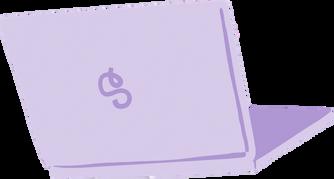
Long “a”: “ai,” “ay”
• “ai” Sound-Spelling Board
• “ay” Sound-Spelling Board
Need to Eat (“ee,” “ea”)
The Gray Stain (“ai,” “ay”)
who
am
• its
now
• Flip It! Read It! Swat It!
• Fix the Word
• Shout It, Sound It!
• Shout It, Spell It!
• Move and Groove
• Hopscotch
• Connect Four
Long “o”: “oa,” “ow”
• “oa” Sound-Spelling Board
• “ow” Sound-Spelling Board
Owen and His Boat (“oa,” “ow”)
find
long
• Minute to Write It
• Hot or Cold
• Tic-Tac-Toe
• Build and Create Letters
Long “i”: “y,” “igh”
• “y” (cry) Sound-Spelling Board
• “igh” Sound-Spelling Board
A Brave Night (“y,” “igh”)
down
day
• Build and Create New Words
• Telephone
• Go Fish!
Long “u”: “u,” “ew,” “ue”
• “ew” and “ue” Sound-Spelling Board
Rue Tells the Truth (“u,” “ew,” “ue”)
did
get
• Dig, Find, and Write
• Treasure Hunt
• Don’t Find Frankie Fuzz Ball
r-Controlled: “ar,” “or”

• “ar” Sound-Spelling Board
• “or” Sound-Spelling Board

r-Controlled: “er,” “ir,” “ur”
Short and Long “oo”
• “er” Sound-Spelling Board
• “ur” and “ir” Sound-Spelling Board
Waiting for Cora (“ar,” “or”)
A Lunch Surprise (“er,” “ir,” “ur”)
come
made
• may • part
• Paparazzi
• Environmental Road Trip
• Life-Size Game Board
• “oo” (book) Sound-Spelling Board
• “oo” (moon) Sound-Spelling Board
Scooter and the Storm (Short and Long “oo”)
where
• Make a Song
• Store Eye Spy
• Pictionary
• Stack and Say
• Stack and Read
Diphthongs: “ou,” “ow”
• “ou” and “ow” Sound-Spelling Board
Playing in the House (“ou,” “ow”)
Diphthongs: “oi,” “oy”
• “oi” and “oy” Sound-Spelling Board
The Choice (“oi,” “oy”)
know • before
through
much
• Throw and Catch
• Eye Spy
• Roll, Write, and Say!
• Roll, Write, and Read!
• Memory
• Run With It
• Write the Room
little
• Writing in the Air
• Setting the Table
Week-At-A-Glance
Example

This resource is designed to provide educators with an example weekly framework using Seesaw Early Literacy lessons. This example shows how lessons can be strategically implemented throughout a typical week to supplement or enhance any existing literacy curriculum.
Note: These weeks offer opportunities to introduce or reinforce students’ knowledge of foundational short vowel sounds and high-frequency words. Each day focuses on key aspects of early literacy, such as phonics, word recognition, and decoding.
have, that

Collection: PhenomenalPhonics
Whole Group Instruction
Lesson: “a”Sound-SpellingBoard
Module(s): Introduction,Sort,Blend page1,Segmentpage1
Collection: PhenomenalPhonics
Small Group Or Independent Practice
Partner or Center Activity
Lesson: “a”Sound-SpellingBoard
Module(s): Blendpages2-5,Segment pages2-5
Collection: Letter&WordBook Treehouse
Lessons:
Short“a”Sound&WordBook#1
Short“a”Sound&WordBook#2
Module(s): Read
Collection: PhenomenalPhonics
Collection: High-Frequency Words With Turtle
Lesson: and
Module(s): Intro, Find
Collection: High-Frequency Words With Turtle
Lesson: have
Module(s): Intro, Find
Collection: High-FrequencyWords WithTurtle
Lesson: and
Module(s): Analyze,Spell,Sentence Practice
Collection: High-FrequencyWords WithTurtle
Lesson: and
Module(s): Write,Create,Connect
Collection: High-Frequency Words With Turtle
Lesson: have
Module(s): Analyze, Spell, Sentence Practice
Collection: High-FrequencyWords WithTurtle
Lesson: have
Module(s): Write,Create,Connect
Collection: High-FrequencyWords WithTurtle
Collection: High-Frequency Words With Turtle
Collection: High-Frequency Words With Turtle
Lesson: that
Module(s): Intro, Find
Collection: PhenomenalPhonics
Lesson: “a”Sound-SpellingBoard
Module(s): Writepage1
Collection: High-Frequency Words With Turtle
Lesson: that
Module(s): Analyze, Spell, Sentence Practice
Collection: High-FrequencyWords WithTurtle
Lesson: that
Module(s): Write,Create,Connect
Collection: High-Frequency Words With Turtle
Collection: Phenomenal Phonics
Lesson: “a” Sound-Spelling Board
Module(s): Change page 1, Write pages 2-3
Collection: PhonicsGames
Lessons: FlipIt!ReadIt!SwatIt! FixtheWord ShoutIt,SpellIt!
Module(s): Watch&Play:Letters,Watch& Play Words
Collection: PhenomenalPhonics
Formative Assessment
Lesson: “a”Sound-SpellingBoard
Module(s): QuickCheck
Lesson: and
Module(s): ShowWhatYouKnow
Lesson: have
Module(s): Show What You Know
Lesson: that
Module(s): Show What You Know
Lesson: “a”Sound-SpellingBoard
Module(s): ShowWhatYouKnow
Week-At-A-Glance
Example

This resource is designed to provide educators with an example weekly framework using Seesaw Early Literacy lessons. This example shows how lessons can be strategically implemented throughout a typical week to supplement or enhance any existing literacy curriculum.
Note: These weeks offer opportunities to introduce or reinforce students’ knowledge of foundational short vowel sounds and high-frequency words. Each day focuses on key aspects of early literacy, such as phonics, word recognition, and decoding.
Collection: PhenomenalPhonics
Whole Group Instruction
Small Group Or Independent Practice
Lesson: “pl"and"fl"Sound-Spelling Board
Module(s): Introduction,Sort,Blend, Segment
Collection: Phenomenal Phonics
Lesson: “pl" and "fl" Sound-Spelling Board
Module(s): Change, Write
Collection: PhonicsGames
Partner or Center Activity
Formative Assessment
Lesson: Paparrazzi
Module(s): Change,Write
Collection: PhenomenalPhonics
Lesson: “pl"and"fl"Sound-Spelling Board
Module(s): QuickCheck
Collection: High-FrequencyWords WithTurtle
Lesson: then
Module(s): Intro,Find
Collection: High-FrequencyWords WithTurtle
Lesson: then
Module(s): Analyze,Spell,Sentence Practice
Collection: High-FrequencyWords WithTurtle
Lesson: then
Module(s): Write,Create,Connect
Collection: High-FrequencyWords WithTurtle
Lesson: then
Module(s): ShowWhatYouKnow
Collection: PhenomenalPhonics
Lesson: “bl"and"cl"Sound-Spelling Board
Module(s): Introduction,Sort,Blend, Segment
Collection: PhenomenalPhonics
Lesson: “bl"and"cl" Sound-Spelling Board
Module(s): Change,Write
Collection: PhonicsGames
Lesson: Life-SizeGameBoard
Module(s): Watch&Play:Words
Collection: High-FrequencyWords WithTurtle
Lesson: them
Module(s): Intro,Find
Collection: High-FrequencyWords WithTurtle
Lesson: them
Module(s): Analyze,Spell,Sentence Practice
Collection: High-FrequencyWords WithTurtle
Lesson: them
Module(s): Write,Create,Connect
Collection: PhenomenalPhonics
Lesson: “gl"and"sl"Sound-Spelling Board
Module(s): Introduction,Sort,Blend, Segment
Collection: PhenomenalPhonics
Lesson: “gl"and"sl" Sound-Spelling Board
Module(s): Change,Write
Collection: Letter&WordBook Treehouse
Lessons:
l-BlendsSound&WordBook#1
l-BlendsSound&WordBook#2
Module(s): Read
Collection: PhenomenalPhonics
Lesson: bl"and"cl"Sound-Spelling Board
Module(s): QuickCheck
Collection: High-FrequencyWords WithTurtle
Lesson: them
Module(s): ShowWhatYouKnow
Collection: PhenomenalPhonics
Lesson: gl"and"sl"Sound-Spelling Board
Module(s): QuickCheck
Week-At-A-Glance
Example

This resource is designed to provide educators with an example weekly framework using Seesaw Early Literacy lessons. This example shows how lessons can be strategically implemented throughout a typical week to supplement or enhance any existing literacy curriculum.
Note: These weeks introduce and deepen students’ understanding and application of various sound-spelling patterns in isolation and in context with short reading passages. Each day in the week provides opportunities to practice decoding, word recognition, reading comprehension, and fluency.
Whole Group Instruction
Small Group Or Independent Practice
Collection: PhenomenalPhonics
Lesson: "Longa"Sound-Spelling Board
Module(s): Introduction,Sort
Collection: PassagesPlayhouse
Lesson: AGameofChase(“a e”)
Module(s): Preview,Act1:EchoRead andMore!
Collection: PhonicsGames
Partner or Center Activity
Lesson: MakeaSong
Module(s): Watch&Play:Words
Collection: PhenomenalPhonics
Formative Assessment
Lesson: “Longa”Sound-Spelling Board
Module(s): QuickCheck
Collection: High-FrequencyWords WithTurtle
Lesson: could
Module(s): Intro,Find,Spell
Collection: PassagesPlayhouse
Lesson: AGameofChase(“a e”)
Module(s): Act2:PracticeReadand More!
Collection: High-FrequencyWords WithTurtle
Lesson: could
Module(s): Analyze,Write,Create, SentencePractice
Collection: High-FrequencyWords WithTurtle
Lesson: could
Module(s): ShowWhatYouKnow
Collection: PhenomenalPhonics
Lesson: "Longa"Sound-Spelling Board
Module(s): Introduction,Blend, Segment
Collection: PassagesPlayhouse
Lesson: AGameofChase(“a e”)
Module(s): Act3:ChoralReadand More!
Collection: PhonicsGames
Lesson: StoreEyeSpy
Module(s): Watch&Play:Words
Collection: PhenomenalPhonics
Lesson: “Longa”Sound-Spelling Board
Module(s): ShowWhatYouKnow
Collection: High-FrequencyWords WithTurtle
Lesson: people
Module(s): Intro,Find,Spell
Collection: PassagesPlayhouse
Lesson: AGameofChase(“a e”)
Module(s): Act4:Reader’sTheaterand More!
Collection: High-FrequencyWords WithTurtle
Lesson: people
Module(s): Analyze,Write,Create, SentencePractice
Collection: High-FrequencyWords WithTurtle
Lesson: people
Module(s): ShowWhatYouKnow
Collection: PhenomenalPhonics
Lesson: "Longa"Sound-Spelling Board
Module(s): Introduction,Change,Write
Collection: PassagesPlayhouse
Lesson: AGameofChase(“a e”)
Module(s): Act5:ReadonYourOwn andMore!
Collection: PhonicsGames
Lesson: Pictionary
Module(s): Watch&Play:Words
Optional: Listen to students reading or check responses from small group, independent practice, or centers.


With Seesaw Early Literacy, our mission is to foster joyful learning opportunities for both educators and students alike. We hope that these lessons not only supplement your teaching but also inspire a love for early literacy in your students. Together, let’s embark on a journey of exploration, discovery, and meaningful engagement in the world of literacy.
Seesaw Early Literacy’s 2nd Grade 30-week scope and sequence is organized from high-utility to low-utility skills. It builds upon the simplest to the most complex understanding of words, ensuring a strategic progression in literacy development guided by the principle that continuous application of previous learning is important (Blevins, 2017).
This scope and sequence of lessons is thoughtfully crafted to align with the dynamic needs of teachers’ classrooms. Within this framework, teachers are encouraged to explore and select any of the lessons listed for a particular week, allowing the freedom to tailor their instruction to best meet instructional objectives and students’ needs. Whether teachers prefer whole-class engagement, collaborative partner activities, interactive small group centers, individualized review work, or any other pedagogical approach, these lessons can be seamlessly integrated into a teacher’s existing curriculum.


Short Vowels: “o,” “e,” “u”
Short “a” and “i” Word
Short “a” and “i”
Word Work
Cam and His Bag (Short “a,” “i”)
• Flip It! Read It! Swat It!
• Fix the Word
• Shout It, Spell It!
Digraphs: “sh,” “ch/ tch,” “th”
Short “o,” “e,” and “u”
Word Analysis
Short “o,” “e,” and “u”
Word Work
“sh,” “ch/tch,” and “th”
Word Analysis
“sh,” “ch/tch,” and “th”
Word Work
A Pet Mess (Short “o,” “e,” “u”)
• Move and Groove
• Hopscotch
• Connect Four
• Minute to Write It
Beth at the Beach (“sh,” “ch/tch,” “th”)
• Hot or Cold
• Tic-Tac-Toe
Digraphs: “wh,” “ng,” “ph”
Short Vowels: “a,” “i” Closed Syllables
“wh,” “ng,” and “ph”
Word Analysis
“wh,” “ng,” and “ph”
Word Work
Phil Takes a Breath (“wh,” “ng,” “ph”)
• Build and Create New Words
• Telephone
• Go Fish!
Closed Syllables
Word Work
The Winter Hike (Closed Syllables)
• Dig, Find, and Write
• Treasure Hunt
• Don’t Find Frankie Fuzz Ball

Closed & Consonant +le
l-Blends
r-Blends
s-Blends
Final Blends

l-Blends Word Analysis
Closed & Consonant +le Word Work
Axle and Freckles (Closed & Consonant +le)
• Paparazzi
• Environmental Road Trip
• Life-Size Game Board
The Clean Up (l-Blends)
• Make a Song
• Store Eye Spy
• Pictionary
r-Blends Word Analysis
s-Blends Word Analysis
Closed & Consonant +le Word Analysis Final Blends Word
• Stack and Read
• Throw and Catch
• Eye Spy
Scram, Skunk! (s-Blends)
A Gray Day (r-Blends) A Kind Sport (Final
• Roll, Write, and Read!
• Memory
• Run With It
• Write the Room
• Writing in the Air
• Setting the Table


Sable’s Choice (Open & Consonant +le)
• Flip It! Read It! Swat It!
• Fix the Word
• Shout It, Spell It!
• Move and Groove
• Hopscotch
• Connect Four
A Visit to the Bakery (“a_e”)
My Baby Brother (Open Syllables) A Sweet Tune (“o
• Minute to Write It
• Hot or Cold
• Tic-Tac-Toe
• Build and Create New Words
• Telephone
• Go Fish!
• Dig, Find, and Write
• Treasure Hunt
• Don’t Find Frankie Fuzz Ball
Long “a”: “ai,” “ay”

“ai” and “ay” Word Analysis

“ai” and “ay” Word Work
The Plane Trip (“ai,” “ay”)
• Paparazzi
• Environmental Road Trip
• Life-Size Game Board
Long “e”: “ee,” “ea,” “ie,” “y”
Long “o”: “oa,” “ow”
“oa” and “ow” Word Analysis “ee,” “ea,” and “y” Word Analysis
“oa” and “ow” Word Work “ee,” “ea,” and “y” Word Work
The Hungry Bee (“ee,” “ea,” “ie,” “y”)
• Make a Song
• Store Eye Spy
• Pictionary
A Slow Float (“oa,” “ow”)
• Stack and Read
• Throw and Catch
• Eye Spy
Long “i”: “igh,” “y”
“igh” and “y” Word Analysis
Long “u”: “ew,” “ue”
“ew” and “ue” Word Analysis
“igh” and “y” Word Work
The Big Slide (“i e,” “igh,” “y”)
• Roll, Write, and Read!
• Memory
• Run With It
• Write the Room
“ew” and “ue” Word Work
A New Design (“ew,” “ue”)
• Writing in the Air
• Setting the Table

r-Controlled: “ar”
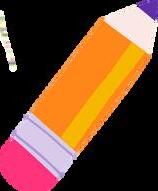
“ar” Word Work
A Day at the Farm (“ar”)
• Flip It! Read It! Swat It!
• Fix the Word
• Shout It, Spell It!
r-Controlled: “or,” “ore,” “oar ”
r-Controlled: “er,” “ir,” “ur”
“or,” “ore,” and “oar” Word Analysis
“or,” “ore,” and “oar” Word Work
A Stormy Morning (“or,” “ore”)
• Move and Groove
• Hopscotch
• Connect Four
r-Controlled & Consonant +le
“er,” “ir,” “ur” Word
“er,” “ir,” and “ur” Word Work
Taking Turns (“er,” “ir,” “ur”)
• Minute to Write It
• Hot or Cold
• Tic-Tac-Toe
r-Controlled & Consonant +le Word
r-Controlled & Consonant +le Word Work
Looking for a Turtle (r-Controlled & Consonant +le)
• Build and Create New Words
• Telephone
• Go Fish!
Short “oo”
Short “oo” Word Work
Brooke and Woody (Short “oo”)
• Dig, Find, and Write
• Treasure Hunt
• Don’t Find Frankie Fuzz Ball
Long “oo”

Long “oo”
Word Analysis

Long “oo”
Word Work
A Trip to the Zoo (Long “oo”)
• Paparazzi
• Environmental Road Trip
• Life-Size Game Board
Diphthongs: “ou,” “ow”
“ou” and “ow”
Word Analysis
“ou” and “ow”
Word Work
Scout and the Mouse (“ou,” “ow”)
• Make a Song
• Store Eye Spy
• Pictionary
Diphthongs: “oi,” “oy”
“oi” and “oy”
Word Analysis
“oi” and “oy”
Word Work
Latoya Helps (“oi,” “oy”)
• Stack and Read
• Throw and Catch
• Eye Spy
/aw/: “au,” “aw”
“au” and “aw”
Word Analysis
“au” and “aw”
Word Work
The Awful Drawing (“au,” “aw”)
• Roll, Write, and Read!
• Memory
• Run With It
• Write the Room
/aw/: “all,” “alk,” “alt”
“all” “alk,” and “alt”
Word Analysis
“all” “alk,” and “alt”
Word Work
Broken Chalk (“all,” “alk,” “alt”)
• Writing in the Air
• Setting the Table
Week-At-A-Glance
Example

This resource is designed to provide educators with an example weekly framework using Seesaw Early Literacy lessons. This example shows how lessons can be strategically implemented throughout a typical week to supplement or enhance any existing literacy curriculum. In second grade, each week offers opportunities to introduce or reinforce students’ knowledge of foundational sound-spelling patterns. Students practice vocabulary building, word analysis, fluency, and reading comprehension in isolation and in context.
3
Whole Group Instruction

4
Small Group Or Independent Practice
Module(s): Write Focus Day 1 Day 2
Partner or Center Activity
Collection: Passages Playhouse
Lesson: A Slow Float (“oa,” “ow)
Module(s): Preview Collection: Passages Playhouse
Lesson: A Slow Float (“oa,” “ow)
Module(s): Act 1: Echo Read and More!
Collection: Phonics Games
Lesson: Flip It! Read It! Swat It!
Module(s): Watch & Play: Words
Collection: Word Analysis Station
Lesson: “oa” and “ow” Word Analysis
Module(s): ‘oa” Analysis
Collection: Passages Playhouse
Lesson: A Slow Float (“oa,” “ow)
Module(s): Act 2: Practice Read and More!
Collection: Phonics Games
Lesson: Fix the Word
Module(s): Watch & Play: Words
Collection: Word Analysis Station
Lesson: “oa” and “ow” Word Analysis
Module(s): ‘ow” Analysis
Collection: Willow’s Word Work
Lesson: “oa” and “ow” Word Work
Module(s): Sort
Collection: Passages Playhouse
Lesson: A Slow Float (“oa,” “ow)
Module(s): Act 3: Choral Read and More!
Collection: Word Analysis Station
Lesson: “oa” and “ow” Word Analysis
Module(s): Comparison Analysis
Collection: Willow’s Word Work
Lesson: “oa” and “ow” Word Work
Module(s): Change
Collection: Passages Playhouse
Lesson: A Slow Float (“oa,” “ow)
Module(s): Act 4: Reader’s Theater and More!
5
Collection: Word Analysis Station
Lesson: “oa” and “ow” Word Analysis
Module(s): Multisyllabic Word Analysis
Collection: Willow’s Word Work
Lesson: “oa” and “ow” Word Work
Collection: Phonics Games
Lesson: Shout It, Spell It!
Module(s): Watch & Play: Words
Optional:
Formative Assessment
Listen to students reading or watch videos from centers.
Optional:
Listen to students reading or watch videos from centers.
Optional:
Listen to students reading or check responses from centers.
Collection: Willow’s Word Work
Lesson: “oa” and “ow” Word Work
Module(s): Quick Check
Collection: Passages Playhouse
Lesson: A Slow Float (“oa,” “ow)
Module(s):
Act 5: Read on Your Own and More!
Week-At-A-Glance
Example:

Collection: Passages Playhouse
This resource is designed to provide educators with an example weekly framework using Seesaw Early Literacy lessons. This example shows how lessons can be strategically implemented throughout a typical week to supplement or enhance any existing literacy curriculum. In second grade, each week offers opportunities to introduce or reinforce students’ knowledge of foundational sound-spelling patterns. Students practice vocabulary building, word analysis, fluency, and reading comprehension in isolation and in context.

Lesson: A Slow Float (“oa,” “ow)
Module(s): Preview
Collection: Passages Playhouse
Lesson: A Slow Float (“oa,” “ow)
Module(s): Act 1: Echo Read and More!
Collection: Phonics Games
Lesson: Flip It! Read It! Swat It!
Module(s): Watch & Play: Words
Collection: Word Analysis Station
Lesson: “oa” and “ow” Word Analysis
Module(s): ‘oa” Analysis
Collection: Passages Playhouse
Lesson: A Slow Float (“oa,” “ow)
Module(s): Act 2: Practice Read and More!
Collection: Phonics Games
Lesson: Fix the Word
Module(s): Watch & Play: Words
Collection: Word Analysis Station
Lesson: “oa” and “ow” Word Analysis
Module(s): ‘ow” Analysis
Collection: Willow’s Word Work
Lesson: “oa” and “ow” Word Work
Module(s): Sort
Collection: Passages Playhouse
Lesson: A Slow Float (“oa,” “ow)
Module(s): Act 3: Choral Read and More!
Collection: Word Analysis Station
Lesson: “oa” and “ow” Word Analysis
Module(s): Comparison Analysis
Collection: Willow’s Word Work
Lesson: “oa” and “ow” Word Work
Module(s): Change
Collection: Passages Playhouse
Lesson: A Slow Float (“oa,” “ow)
Module(s): Act 4: Reader’s Theater and More!
Collection: Word Analysis Station
Lesson: “oa” and “ow” Word Analysis
Module(s): Multisyllabic Word Analysis
Collection: Willow’s Word Work
Lesson: “oa” and “ow” Word Work
Module(s): Write
Collection: Phonics Games
Lesson: Shout It, Spell It!
Module(s): Watch & Play: Words
Optional:
Listen to students reading or watch videos from centers.
Optional:
Listen to students reading or watch videos from centers.
Optional:
Listen to students reading or check responses from centers.
Collection: Willow’s Word Work
Lesson: “oa” and “ow” Word Work
Module(s): Quick Check
Collection: Passages Playhouse
Lesson: A Slow Float (“oa,” “ow)
Module(s): Act 5: Read on Your Own and More!


Phonemic awareness is the understanding that a word consists of a sequence of distinc (phonemes). Fun Phonemes covers over 40 major phonemes in the English language, p students with opportunities to practice these sounds both in isolation and in context. Ea focuses on a specific phoneme and guides students through a progression of activities that gradually increase in complexity to systematically build students' awareness and manipulation skills for each phoneme.
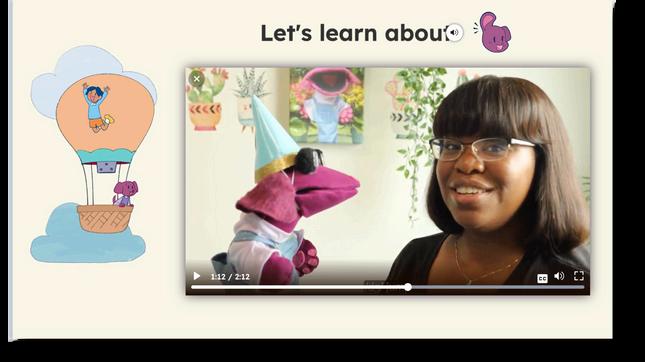
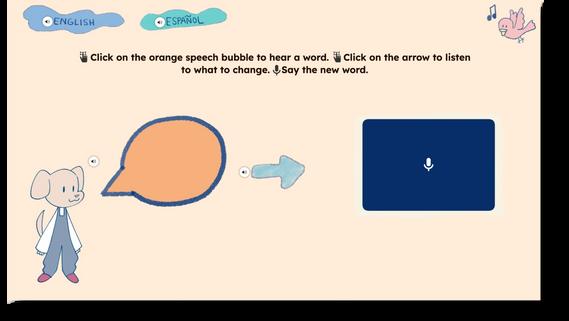


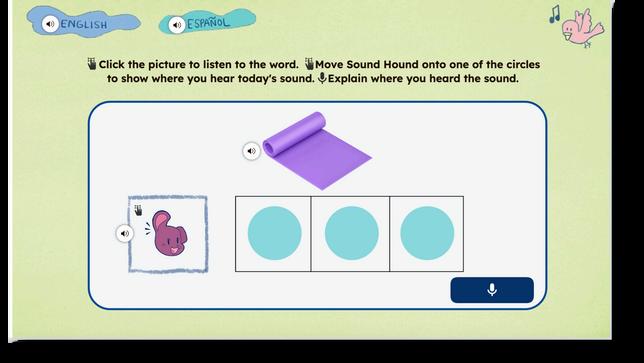
Follow the Sequence: The lesson sequence is intentionally aligned with the natural progression of speech sound acquisition, ensuring a structured pathway for effective learning based on research.
Model Articulatory Gestures: Utilize the provided lesson videos as a resource to consistently and accurately model articulatory gestures for each phoneme. Pause the video at key moments to highlight specific aspects of the articulation and encourage students to mirror your movements, practicing along with you.
Flexible Implementation for Differentiated Learning: These lessons are designed for versatile use, allowing for small group instruction, one-on-one support, or asynchronous learning. While younger students might benefit from guided practice with an adult, the consistent and predictable structure of the activities supports increasing independence over time.



Understanding that words are made of letters and connecting letters with their sounds foundational skill called the alphabetic principle. Alphabet Garden includes over 100 le expose and introduce early learners to capital letters, lowercase letters, and the sound y make. These lessons invite students to recognize the letters in isolation and in context, practice letter formation, and associate a sound with them to support foundational early literacy development through engaging and multisensory activities.
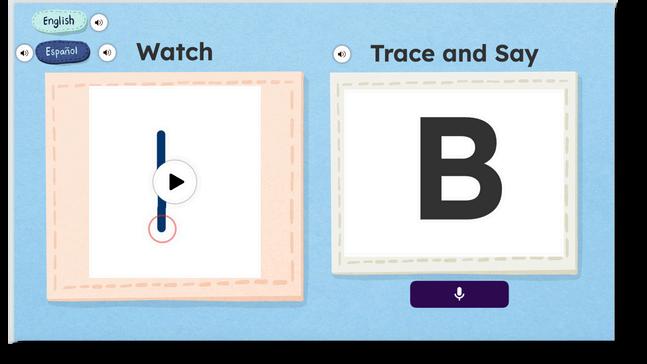



Gradual Release: Introduce new lessons as a whole group to model how to complete the activity. Practice the gradual release method as students begin to gain confidence and independence.
Fine Motor Skills Development: Enhance letter formation practice by incorporating activities that strengthen fine motor skills such as tracing, cutting, or using manipulatives.

Sharing: Allow students to share their ideas with others around them. As students make connections to letters encourage opportunities to discuss what they notice or have discovered about each letter.
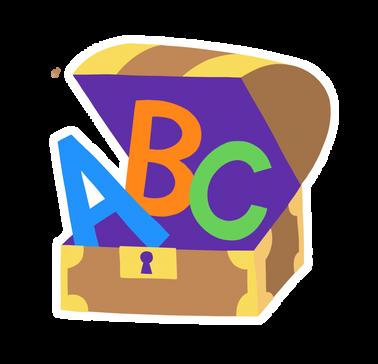

Alphabet recognition, being able to quickly and accurately identify letters, is a crucial learners as they learn to read and write. Alphabet Treasures features 26 lessons, each a specific letter, that provide students with engaging activities to actively explore the r p between each letter's name, its corresponding sound, and the visual representation and proper formation of capital and lowercase forms. In each lesson, as students interact with letters by sorting, identifying, hearing, and writing them, they strengthen their foundation in letter knowledge.

Click here to view the collection


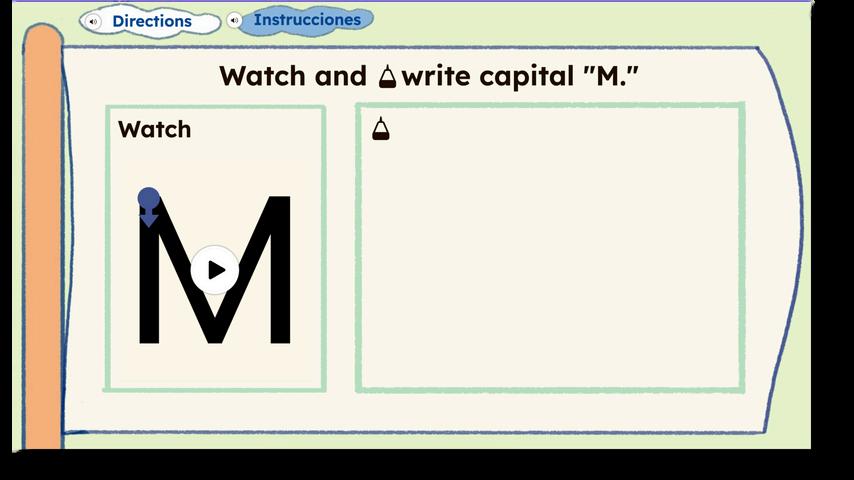
Contextualized Learning: Create multiple opportunities to present the focus letter in isolation and within words to deepen students' understanding of its use across a variety of authentic contexts.
Environmental Print Awareness: Bridge the gap between digital learning and everyday print experiences by encouraging students to find objects that begin with or include the target letter to encourage environmental print awareness.

Digital-Physical Balance: Integrate both digital tools and hands-on offline activities to create comprehensive and enriching learning experiences that engage students through multiple modalities.


Phonics instruction deepens students' understanding of the relationships between soun spellings. Phenomenal Phonics offers over 70 comprehensive lessons to provide stude scaffolded and systematic practice opportunities that gradually increase in complexity. Each lesson includes sorting, blending, segmenting, manipulating, and writing activities and also incorporate multisensory approaches to support diverse learning styles to help students become more confident readers and writers.








Systematic Phonics Instruction: The lesson sequence is thoughtfully organized from high-utility to low-utility letters and sound-spelling patterns and builds upon the simplest to most complex skills.
Consistent Recursive Review: Regularly revisit previously learned sound-spelling patterns to reinforce learning and encourage retention. Incorporate spiral review techniques that progressively increase in complexity, allowing students to make connections between various sound-spelling patterns.
Metacognitive Phonics Instruction: Encourage students to be aware of their own learning processes by having them reflect on which strategies they are using, how they are applying phonics rules, and why these skills are helpful. Inviting students to track their progress and share their insights empowers them to deepen their understanding of specific sound-spelling patterns and how they learn best.

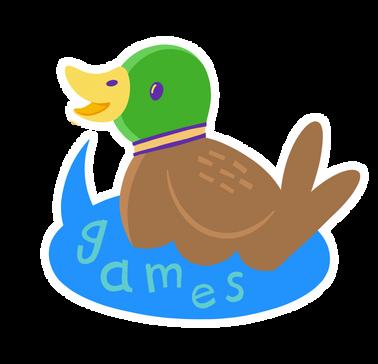

Click here to view the collection
Phonics Games provides an engaging collection of over 30 interactive lessons designe encourage phonics fluency through hands-on, play-based activities. These lessons rein essential skills such as phonemic awareness, letter recognition, phonological awareness, decoding, and spelling through customizable offline games that can be played independently or with partners. Each game features both letter-focused and word-focused versions, making them adaptable to various sound-spelling patterns.

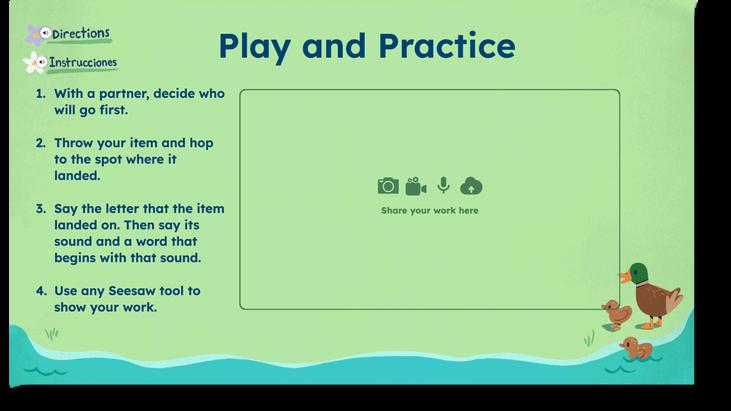



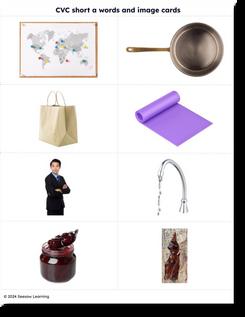
Focus on Fun: Keep the atmosphere light-hearted and enjoyable to maintain student motivation and enthusiasm for practicing essential phonics skills.
Encourage Reflection: Foster metacognitive skills by prompting students to reflect on their learning processes and the strategies they use during games.

Home Connection: These games allow students and families to extend learning at home and provide them with a repository of activities to accelerate skill-building at home.


Click here to view the collection
Decoding, the skill of connecting letters or letter combinations to their corresponding s sound out words while reading, is a fundamental early literacy skill. The Letter & Word Treehouse collection features over 70 engaging short books filled with real, relatable images that provide students with opportunities to practice alphabet recognition and decoding skills. Each book focuses on a different letter or sound-spelling pattern such as short vowels, long vowels, digraphs, inflectional endings, double consonants, and consonant blends. As students interact with these books, they actively explore common sound-spelling relationships, strengthen their oral language skills, and expand their vocabulary.




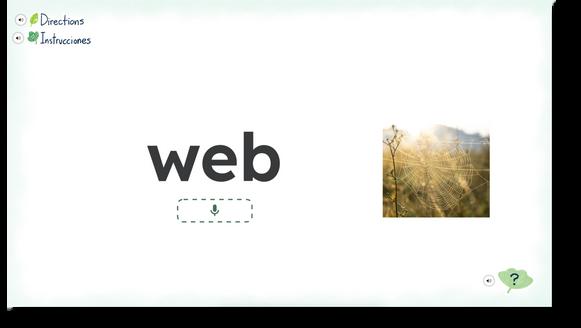
Contextualized Learning: Utilize the real, relatable images in the short books to help students connect letters and words to meaningful contexts. This approach enhances their understanding and retention of soundspelling patterns.
Multi-Sensory Engagement: Incorporate activities that involve multiple senses, such as having students trace letters while saying their names and sounds, or using physical movements to represent different blends. This reinforces learning through various modalities.
Progressive Skill Building: Structure lessons to gradually introduce and build upon different sound-spelling patterns, starting with simple short vowels and progressing to more complex patterns like digraphs and blends. This systematic approach allows students to develop their skills incrementally while reinforcing previous learning.

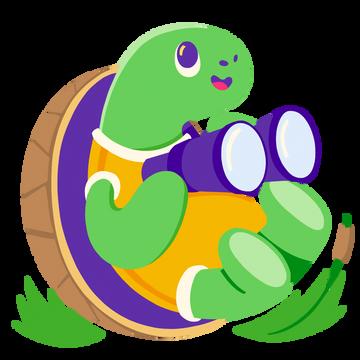

Word recognition, the ability to quickly and accurately identify written words without n decode them phonetically, is an important skill that enables fluent reading and compre High-Frequency Words With Turtle provides a comprehensive approach to strengthening students’ word recognition skills of over 100 high-frequency words that account for 50% of the words commonly found in children’s texts. Each lesson focuses on a specific high-frequency word and guides students through a series of activities to analyze, identify, spell, write, and use the word. Through repeated exposure and practice, students develop automaticity in recognizing these words.


Click here to view the collection



Orthographic Mapping: Guide students to say the focus word aloud, stretch out each sound, write the word, and identify any regular or unusual spelling patterns within the word. Encouraging students to share their observations helps them connect the pronunciation, spelling, and meaning of the word.
Contextual Reading Practice: Provide opportunities for students to apply their word recognition skills in connected text, allowing them to see how the words function within sentences and longer narratives.

Repeated Exposure and Practice: Implement consistent practice sessions with these 109 high-frequency words, as they form a significant portion of children's texts. Regular review and repetition will help solidify recognition and usage of these words, improving overall reading fluency.


Word Analysis Station offers a comprehensive approach to exploring words by exami sounds, spellings, and syllables. Through engaging activities and conversations, studen their understanding of these patterns and gain confidence in applying them to their reading and writing. Additionally, students examine how inflectional endings work and delve into the meanings of compound words. While primarily designed as teacher-guided lessons to preview focus patterns, these versatile activities can also serve as review materials or supplemental support.




Integrated Word Study: Combine the exploration of sound-spelling patterns, syllables, and word meanings with the study of inflectional endings and compound words. This comprehensive approach helps students understand words from multiple angles, reinforcing their overall language skills.
Interactive Discussions: Facilitate engaging conversations about words and their patterns to deepen student understanding. Encourage students to share their observations, ask questions, and make connections, fostering a collaborative learning environment that enhances retention and application of new concepts.
Flexible Implementation: Utilize Word Analysis Station as both a preview tool for new patterns and a review resource for reinforcement. Adapt the activities to suit your students' needs, using them for whole-class instruction, small group work, or individual practice. This flexibility allows for targeted support and differentiation based on student progress and learning goals.



Click here to view the collection
Word awareness activities challenge students to apply and expand their understanding previously taught phonics skills, strengthening their grasp of word structure and spellin conventions. Willow's Word Work guides students through a series of engaging, hands-on activities that explore complex sound-spelling and syllable patterns. Through carefully designed word sorts, word ladders, and dictation exercises, each lesson offers students multiple opportunities to integrate new knowledge with existing skills, fostering a deeper comprehension of how words work.




Multisensory Exploration: Use a variety of activities that engage different senses, like visual sorts, auditory exercises, and hands-on word manipulations. This multisensory approach reinforces sound-spelling patterns and syllable structures, enhancing engagement and effectiveness for all learners.
Progressive Skill Building: Utilize the collection's structure of open sorts, closed sorts, and time sorts to gradually increase the complexity of the activities. This scaffolded approach allows students to build confidence and independence as they deepen their understanding of the focus patterns.
Integrated Writing Practice: Regularly incorporate writing activities that focus on words, phrases, and sentences using the target patterns. This practice helps students apply their knowledge in context, reinforcing their understanding of how these patterns function in real-world writing scenarios and strengthening the connection between phonics knowledge and practical literacy skills.



Providing authentic reading experiences for students to practice learned phonics skills for developing proficient readers. Passages Playhouse features over 50 short, controll passages designed to help students enhance their decoding, fluency, and reading comprehension skills. Each passage focuses on a specific sound-spelling or syllable pattern and is structured with five days of activities that progressively increase in complexity throughout the week. This systematic approach ensures that all learners can thrive as they advance their literacy skills, while consistently applying their phonics knowledge to authentic reading experiences.




Preview the Text: Before reading, preview the text with students and pre-teach any vocabulary to build background knowledge and enhance comprehension. This practice activates prior knowledge and sets students up for success by familiarizing them with the content and structure of what they are about to read.
Dictation and Encoding Practice: Include spelling and writing activities to reinforce the connection between reading and writing.

Guided Reading Practice: Provide opportunities for students to read the controlled passages with teacher support and integrate questions and discussions to ensure students understand what they’re reading. This scaffolded approach allows teachers to model effective reading strategies and offer immediate feedback.


Adria Klein, Ph.D., is the Trainer and Director of the Comprehensive Literacy Center at one of the oldest colleges in California, and professor emerita of reading education at CSU San Bernardino where she was the Chair of the Department of Elementary and Bilingual Education. She earned her Ph.D. at the University of New Mexico in Reading and ESL. Dr. Klein is the co-author of many professional books and articles on reading and writing instruction and intervention, oral language development, multiliteracy learning, and early mathematics learning.
Kia Myrick McDaniel, Ed.D., has dedicated her career to supporting and developing equitable educational opportunities for culturally and linguistically diverse students. She currently holds the position of Director of Curriculum and Instruction in a large urban school district, serving a student population of over 130,000, with 20% of them being multilingual learners. Dr. McDaniel brings a wealth of experience, having previously held positions as a classroom teacher, reading specialist, ESOL teacher, Supervisor of ESOL, and Coordinating Supervisor of Specialty Programs. She also serves as an adjunct professor and consultant. In these roles, she conducts professional development workshops, designs and evaluates curricula, and assists school districts and organizations in developing resources to meet the needs of multilingual learners.
Blevins, W. (2017). A fresh look at phonics: Common causes of failure and 7 ingredients for success. Corwin.
Blevins, W. (2023). Phonics from A to Z: A practical guide. Scholastic.
Burkins, J., & Yates, K. (2021). Shifting the balance: 6 ways to bring the science of reading into the blanched literacy classroom. Stenhouse.
Duke, N. K., Ward, A. E., & Pearson, P. D. (2021). The science of reading comprehension instruction. The Reading Teacher, 74(6), 663-672. https://doi.org/10.1002/trtr.1993
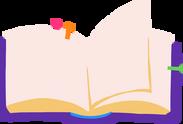
Foorman, B.R., Chen, D. T., Carlson, C., Moats, L., Francis, D.J., & Fletcher, J.M. (2003). Necessity of the alphabetic principle to phonemic awareness instruction. Reading and Writing, 16, 289–324.
McBreen, M., & Savage, R. (2020). The impact of motivational reading instruction on the reading achievement and motivation of students: A systematic review and meta-analysis. Educational Psychology Review. Advance online publication. https://doi.org/10.1007/s10648-020-09584-4
Moats, L.C. (Summer, 2019). Teaching spelling: An opportunity to unveil the logic of language. Perspectives on Language and Literacy, 45(3),17–20.
Petscher, Y., Cabell, S. Q., Catts, H. W., Compton, D. L., Foorman, B. R., Hart, S. A., Lonigan, C. J., Phillips, B. M., Schatschneider, C., Steacy, L. M., Terry, N. P., & Wagner, R. K. (2020). How the Science of Reading Informs 21st-Century Education. Reading research quarterly, 55(Suppl 1), S267–S282. https://doi.org/10.1002/rrq.352
Saha, N. (2022, December 14.) The Science Behind Decodable Books. Metametrics, Inc. https://metametricsinc.com/thescience-behind-decodable-books/
Suggate, S. P. (2016). A meta-analysis of the long-term effects of phonemic awareness, phonics, fluency, and reading comprehension interventions. Journal of Learning Disabilities, 49(1), 77-96.
